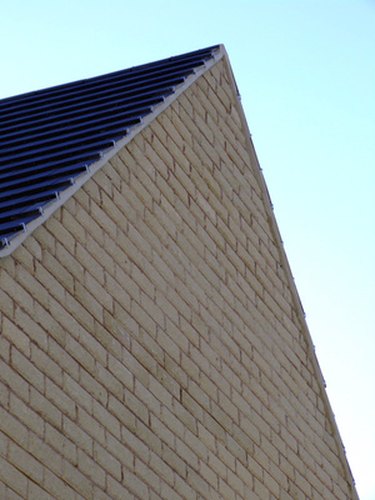Things You'll Need
Pre-engineered trusses
Ladders
2-by-4 inch bracing
Purlins
Moisture barrier
Metal roofing
Nails
Roofing screws
Roofing trim

Building a roof can be one of the more difficult aspects of construction, especially if the roof has dormer windows and complex angles. The gable roof is advantageous because it is relatively easy to construct and has lower maintenance requirements than other styles. Using pre-engineered trusses is the simplest way to install a new gable roof and can usually be done with no mechanical lifting equipment. Trusses are triangular roof frames with zigzag supports. The size and thickness of the trusses will be determined by the size of the building and the proximity of the trusses to each other.
Step 1
Build or order roof trusses for a gable style roof made of either wood or galvanized metal channels. Galvanized metal channel trusses will be much lighter and easier to install. The roof and truss design should be approved by your local building department before beginning any construction work.
Video of the Day
Step 2
Lift all the trusses onto the top of the walls by lifting one end at a time using ladders and then slide one truss into position at one end of the building. If the trusses are too heavy to safely lift manually, use mechanical lifting equipment. Before mounting the first truss fasten vertical braces at the end wall each with planks as angular support. See reference entitled "Truss Erecting and Bracing."
Step 3
Rotate the first hanging truss up 180 degrees propping it into an upright position using 2-by-4 planks and ropes. Fasten the truss temporarily to the two end braces using screws and an electric drill. Nail the base of the truss into place at the two ends using metal framing anchor clips and appropriate sized nails depending on the timber size.
Step 4
Lift up the second truss and mount in its proper place using metal framing anchor clips at the ends. Screw on wood planks as temporary bracing on top of the two trusses using screws and a power drill. Mount a third truss in the same manner and begin adding thin, long wood planks known as purlins perpendicularly across the tops of the trusses as close together as specified by the roof design.
Step 5
Nail down plastic roofing moisture barrier on top of the trusses and purlins after they have all been fully installed. Screw down metal roofing sheets one by one using a power drill and beginning at the right-hand side of the roof if you are right handed. Wide-span metal roofing sheets are usually installed in a vertical orientation and panels should be seamless from the top of the peak to the lower overhang edge.
Step 6
Finish the roof by attaching a metal ridge to the crown of the roof and add trim and gutters as required. Attach hurricane roof clips or straps to the underside of the roof if hurricanes are a threat in your location. Add required additional timber to the end wall faces to support exterior wall siding.
Tip
Use stainless steel roofing screws to install the roof panels and trim.
Warning
If you live in an area prone to heavy snows, the roof's designed strength should be increased for such conditions. Make sure you have all necessary building permits before beginning any construction work.
Video of the Day